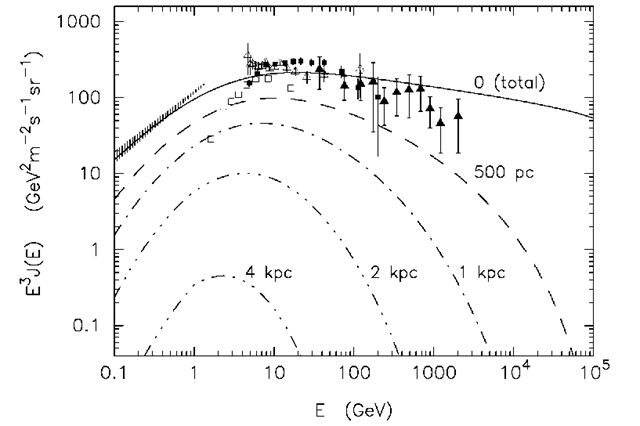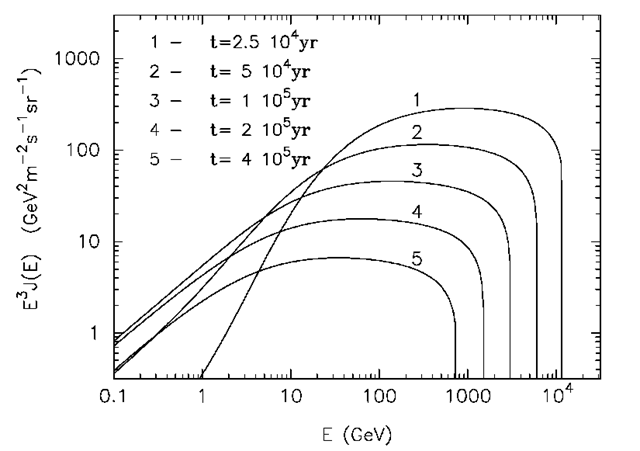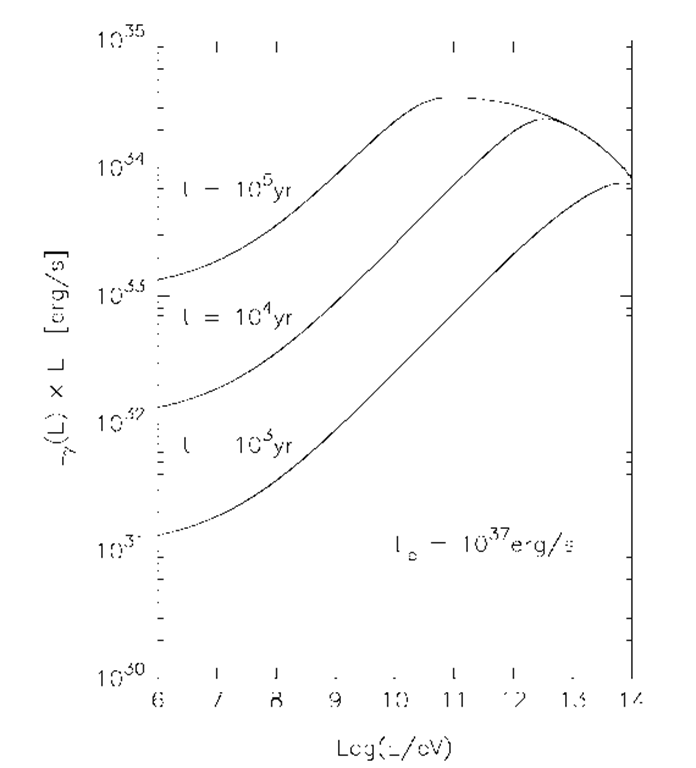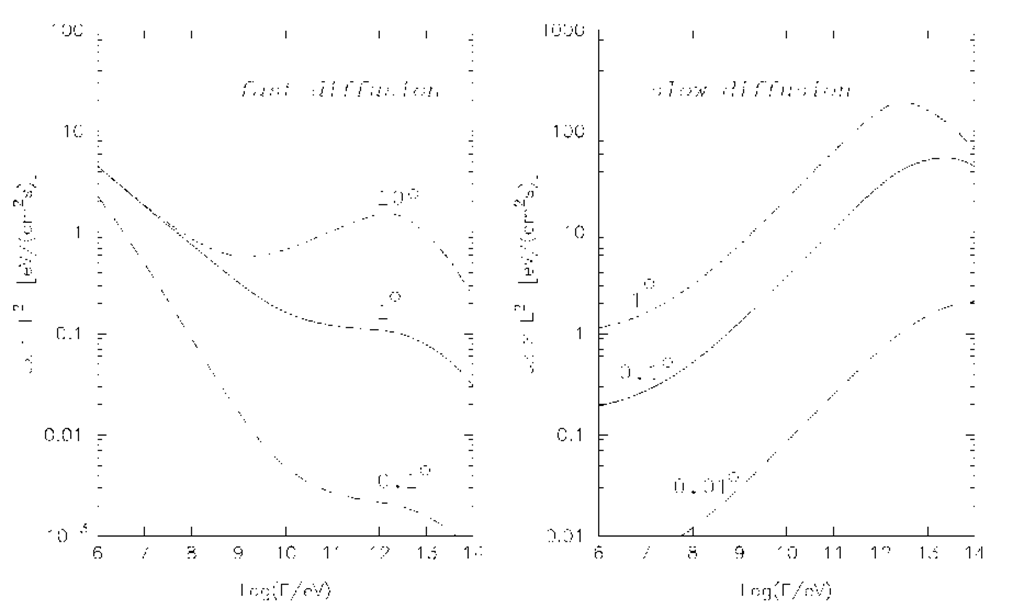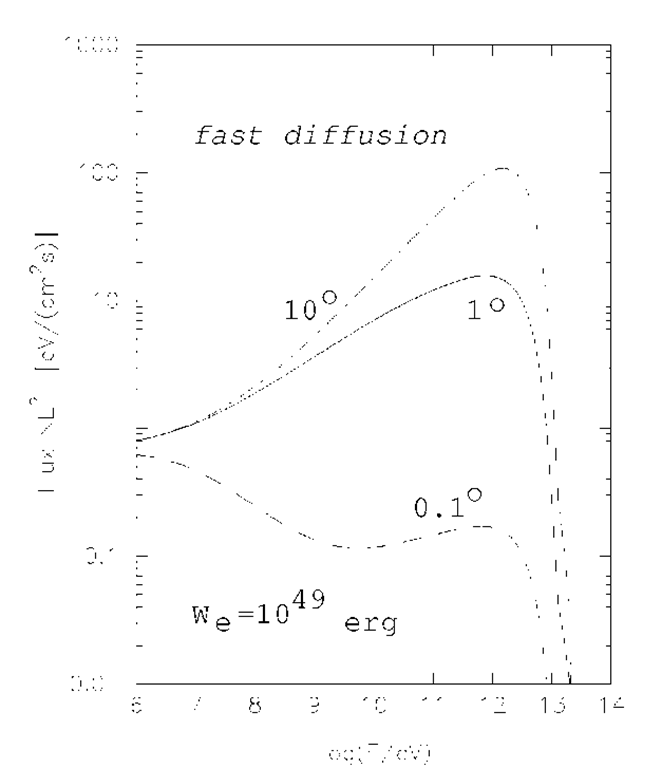The standard interpretation of the energy spectrum of CRs usually assumes a uniform and continuous distribution of sources in the Galaxy both in space and time. Whereas for the nucleonic component of CRs this approximation can be considered as a reasonable (although not undisputable) working hypothesis, the validity of this assumption for the electrons is questionable, at least for the high energy part of the measured spectrum which extends up to TeV energies.
In Fig. 4.12 the energy spectrum of CR electrons calculated assuming a uniform and continuous distribution of the sources in the Galactic Disk (solid curve) is decomposed to show the contributions from sources located at distances![]() for different r0 . It is seen that even at energies
for different r0 . It is seen that even at energies![]() the total flux of the observed electrons is dominated by particles produced and injected into the ISM at distances
the total flux of the observed electrons is dominated by particles produced and injected into the ISM at distances![]() from the Sun. At TeV energies, the sources beyond 1 kpc contribute less than 0.1% of the total electron flux. Note that the calculations are performed assuming rather fast diffusion, with a diffusion coefficient given by Eq.(4.6) with D* = 1028 cm/s and 5 = 0.6 (the power-law acceleration spectrum of electrons is assumed to have r = 2.4). For a smaller diffusion coefficient the contributions from large distances would be even smaller. Since a homogeneous distribution of CR sources (in space and in time) on spatial scales ^ 1 kpc seems unlikely, both the spectrum and the absolute flux of TeV electrons may significantly vary from site to site in the Galactic Disk.
from the Sun. At TeV energies, the sources beyond 1 kpc contribute less than 0.1% of the total electron flux. Note that the calculations are performed assuming rather fast diffusion, with a diffusion coefficient given by Eq.(4.6) with D* = 1028 cm/s and 5 = 0.6 (the power-law acceleration spectrum of electrons is assumed to have r = 2.4). For a smaller diffusion coefficient the contributions from large distances would be even smaller. Since a homogeneous distribution of CR sources (in space and in time) on spatial scales ^ 1 kpc seems unlikely, both the spectrum and the absolute flux of TeV electrons may significantly vary from site to site in the Galactic Disk.
The extended IC Y-radiation of electrons produced in the vicinity of their accelerators, provides a unique tool to search for the electron Teva-trons in our Galaxy.
Distributions of VHE electrons
The energy-loss rate of electrons in Eq.(A.1) for the standard regions of ISM can be presented in the form![]() (in units of s-1). Here
(in units of s-1). Here![]() is for the ionization losses of electrons in the neutral interstellar gas with number density n (in units of cm-3). The second term with
is for the ionization losses of electrons in the neutral interstellar gas with number density n (in units of cm-3). The second term with![]() corresponds to the bremsstrahlung energy losses and the last one, with
corresponds to the bremsstrahlung energy losses and the last one, with![]() and
and![]() (in units of eV/cm3), represents synchrotron and inverse Compton losses
(in units of eV/cm3), represents synchrotron and inverse Compton losses![]() is the 2.7 K CMBR energy density,
is the 2.7 K CMBR energy density,![]() is the energy density of optical-IR radiation in interstellar space; the energy density of the magnetic field is
is the energy density of optical-IR radiation in interstellar space; the energy density of the magnetic field is![]() Note that a more accurate expression for P(y) should take into account that the Compton scattering of electrons with energies
Note that a more accurate expression for P(y) should take into account that the Compton scattering of electrons with energies![]() off the optical photons corresponds to the Klein-Nishina rather than to the Thomson limit.
off the optical photons corresponds to the Klein-Nishina rather than to the Thomson limit.
Fig. 4.12 The flux of CR electrons. The hatched region corresponds to the estimate of the mean flux of low energy electrons derived from radio data in the direction of galactic poles. The calculations demonstrate the relative contributions from different regions of the Galactic Disk to the overall flux of electrons assuming that the sources are continuously and uniformly distributed in the Galactic Disk. The overall flux (solid curve, ro = 0pc) is decomposed in order to show the contributions from the sources located at distances![]() for different ro indicated near the curves.
for different ro indicated near the curves.
However, as long as the energy density of the magnetic field and 2.7 K CMBR is comparable with the density of optical radiation, this approximation provides quite accurate results. Above several GeV, Compton and synchrotron losses dominate over bremsstrahlung and ionization losses. Moreover, for timescales![]() yr, only Compton and synchrotron losses are important, thus
yr, only Compton and synchrotron losses are important, thus![]() This allows a simple analytical description of the density of electrons at a distance R and at time t after their injection from an impulsive source (Atoyan et al., 1995):
This allows a simple analytical description of the density of electrons at a distance R and at time t after their injection from an impulsive source (Atoyan et al., 1995):
where
Fig. 4.13 demonstrates the temporal and spectral features of the electron flux at 100 pc from an impulsive accelerator.
Fig. 4.13 The energy spectra of electrons at different epochs t after their injection into the ISM at 100 pc froman impulsive accelerator. The calculations correspond to the total energy output![]() erg in power-law electrons with
erg in power-law electrons with![]() extending up to
extending up to![]() The diffusion coefficient is the same as in Fig. 4.12.
The diffusion coefficient is the same as in Fig. 4.12.
In the case of continuous injection of electrons from a point source the energy spectrum of electrons is described by
where![]() At low energies Eq.(4.15) has an energy dependence similar to Eq.(4.13) for burst-like injection. However, at higher energies it is qualitatively different. In particular, the steepening of this spectrum at high energies corresponds to a power-law index
At low energies Eq.(4.15) has an energy dependence similar to Eq.(4.13) for burst-like injection. However, at higher energies it is qualitatively different. In particular, the steepening of this spectrum at high energies corresponds to a power-law index![]() Also, the cutoff of the energy spectrum above Ycut expected in the case of burst-like injection, now disappears.
Also, the cutoff of the energy spectrum above Ycut expected in the case of burst-like injection, now disappears.
Extended regions of IC gamma radiation
Electrons ejected by a single accelerator can be traced by their inverse Compton radiation outside the accelerator. The characteristics of this radiation, produced in relatively compact environments of accelerators (e.g. in the pulsar-driven nebulae in the case of pulsars or in the shells in the case of SNRs) are described in the next topics. Here we discuss the characteristics of radiation of these electrons beyond the (possible) compact nebulae, assuming that the cloud of electrons expands in a conventional region of the ISM with magnetic field![]() and a diffuse optical/infrared photon density of
and a diffuse optical/infrared photon density of![]() The synchrotron radiation of multi-TeV electrons peaks at optical or UV frequencies, and because of the diffuse galactic background cannot be detected. At the same time, the X-ray tail of this radiation produced by
The synchrotron radiation of multi-TeV electrons peaks at optical or UV frequencies, and because of the diffuse galactic background cannot be detected. At the same time, the X-ray tail of this radiation produced by![]() electrons may significantly contribute to the diffuse X-ray background of the Galactic Disk (see below).
electrons may significantly contribute to the diffuse X-ray background of the Galactic Disk (see below).
The cloud of electrons expanding in the ISM radiates high energy Y-rays through inverse Compton scattering on the 2.7 K CMBR and on the diffuse interstellar infrared/optical (IR/O) radiation. The high production rate of IC Y-rays is provided predominantly by 2.7 K CMBR photons, although the energy density of IR/O is a factor of 2 to 4 higher than the density of 2.7 K CMBR,![]() Indeed, the emissivity of IC Y-rays in the case of a blackbody distribution of ambient photons in the Thomson regime is proportional to
Indeed, the emissivity of IC Y-rays in the case of a blackbody distribution of ambient photons in the Thomson regime is proportional to
where Tr and Z are the temperature and dilution factor of the radiation, and p is the current power-law index of electrons (Blumenthal and Gould, 1970). Thus, for the parameters characterising the 2.7 K CMBR![]()
![]() and the interstellar IR/O starlight
and the interstellar IR/O starlight![]() ,
,
the contribution from the 2.7 K CMBR dominates as long as![]() In addition, the efficiency of IC scattering on IR/O photons at very high energies drops significantly due to the Klein-Nishina effect. The dominance of the IC radiation due to the up-scattering of the 2.7 K CMBR is a nice feature which allows derivation of robust information about the electrons independent of (poorly known) details, e.g. concerning the spatial variations of the diffuse IR/O radiation in the Galactic Disk.
In addition, the efficiency of IC scattering on IR/O photons at very high energies drops significantly due to the Klein-Nishina effect. The dominance of the IC radiation due to the up-scattering of the 2.7 K CMBR is a nice feature which allows derivation of robust information about the electrons independent of (poorly known) details, e.g. concerning the spatial variations of the diffuse IR/O radiation in the Galactic Disk.
The IC luminosities of the expanding cloud of electrons continuously ejected by an accelerator (e.g. by an isolated pulsar) into the ISM, are shown in Fig. 4.14. Due to the assumed hard spectrum of the electrons, IC scattering on the 2.7 K CMBR dominates over other Y-radiation channels.
Fig. 4.14 The 7-ray luminosity of the expanding "cloud" of relativistic electrons at different epochs. A constant electron injection rate of![]() with a power-law acceleration spectrum (r = 2) extending up to 1015 eV is assumed. The magnetic field is
with a power-law acceleration spectrum (r = 2) extending up to 1015 eV is assumed. The magnetic field is![]() the ambient gas density is
the ambient gas density is![]() , and energy density of O/IR starlight radiation is
, and energy density of O/IR starlight radiation is![]()
At lower energies, E < 1 GeV, the contribution of the bremsstrahlung photons becomes noticeable, especially for steep electron spectra.
The results presented in Fig. 4.14 are obtained by integrating the fluxes over all angles from the central source. Therefore they depend only on the initial spectrum of electrons, but not on the diffusion coefficient. However, the character of diffusion of electrons in the ISM has a crucial impact on the angular distribution of radiation, and thus on the visibility of Y-ray fluxes. This is illustrated in Figs 4.15a,b where the Y-ray fluxes expected within different angles in the direction of the source of electrons are shown. The fluxes are calculated assuming that the relativistic electrons are continuously injected into the ISM with a constant rate Le = 3.5 • 1036 erg/s during the last 104 years from a source at a distance of 0.5 kpc.
Fig. 4.15a corresponds to the "worst" combination of the model parameters in the sense of the detectability of Y-rays. The fast expansion of the cloud of electrons due to the large diffusion coefficient and the relatively soft (r = 2.4) initial spectrum of electrons (which during propagation becomes even steeper due to the energy-dependent diffusion) results in radiation of the bulk of the photons within large angles and at low energies.
Fig. 4.15 IC Y-ray fluxes expected within different detection angles from an electron accelerator located at a distance of 0.5 kpc. The injection rate of electrons is![]() (a) (left) fast diffusion — power-law diffusion coefficient
(a) (left) fast diffusion — power-law diffusion coefficient![]() ; steep spectrum of accelerated electrons with
; steep spectrum of accelerated electrons with![]() (b) (right) slow diffusion — constant diffusion coefficient with
(b) (right) slow diffusion — constant diffusion coefficient with![]() hard spectrum of accelerated electrons with r = 2.
hard spectrum of accelerated electrons with r = 2.
Correspondingly, the Y-ray fluxes in both GeV and TeV energies turn out to be, for the assumed injection rate of electrons, well below the sensitivities of current Y-ray telescopes. The situation could be quite different if electrons with a hard initial spectrum propagate more slowly in the ISM (Fig. 4.15b). For the small diffusion coefficient the bulk of Y-rays are produced with a very hard spectrum in rather compact regions surrounding the source. As a result of this optimistic scenario, the Y-ray fluxes reach a level detectable by GLAST and future IACT arrays
In Fig. 4.16 Y-ray fluxes within different angular distances from an impulsive source are shown. It is assumed that We = 1049 erg, released in the form of relativistic electrons, was injected into ISM at early stages of "operation" of a 104 year old source. It is interesting to note that We = 1049 erg corresponds to the total energy required to explain the (directly) measured fluxes of high energy cosmic ray electrons above E > 100 GeV solely by a nearby single source like the Geminga pulsar.Thus, the next generation of IACT systems with extended 1°) flux sensitivity better than E2J(E) = 10 eV/cm3 should be able to discover similar objects in our Galaxy by detecting characteristic TeV Y-radiation from isolated pulsars located at distances beyond 1 kpc.
The sharp cutoffs in Y-ray spectra shown in Fig. 4.16 are due to radiative loses of electrons produced 104 years ago and not supported by freshly accelerated particles. Therefore such objects could be detected most effectively at E ~ 1 TeV. Older objects obviously require observations at lower energies.
The Y-ray fluxes in Figs. 4.15a,b and 4.16 are calculated for certain sets of model parameters. Note that for the fixed diffusion coefficient and the spectral index of accelerated electrons, the absolute flux and angular size of the IC radiation shown are proportional to![]() and 1/d, respectively. Therefore, the angular and spectral characteristics of IC radiation of other sources with different combinations of Le (or We) and d, can be calculated by renormalization of the curves presented in Figs. 4.15a,b and 4.16.
and 1/d, respectively. Therefore, the angular and spectral characteristics of IC radiation of other sources with different combinations of Le (or We) and d, can be calculated by renormalization of the curves presented in Figs. 4.15a,b and 4.16.
Finally, it is worth noting that the predicted fluxes of GeV Y-rays produced during the propagation of the electrons in the conventional regions of the ISM can be marginally detected by GLAST. However, in the case of expansion of the cloud of electrons in dense![]() regions surrounding an electron accelerator, the fluxes of the bremsstrahlung photons could increase significantly to observable levels.
regions surrounding an electron accelerator, the fluxes of the bremsstrahlung photons could increase significantly to observable levels.
The injection of VHE electrons into the ISM by SNRs and pulsars (or by any other possible sources of high energy electrons) may result in rather high diffuse radiation from some regions of the Galactic Disk. In fact, due to the short propagation paths of VHE electrons, the IC component of the diffuse radiation of the Galactic Disk at high energies should be structured with an increase of the flux towards the discrete electron accelerators. The separation of the high energy IC component from the overall diffuse background of the Galactic Disk, e.g. by searching for specific spatial and spectral variations on angular scales < 10°, would allow identification of the high energy electron accelerators in our Galaxy.
Fig. 4.16 IC Y-ray fluxes expected within different detection angles from an impulsive electron accelerator located at 2 kpc. It is assumed that We = 1049 erg energy of relativistic electrons has been injected into ISM at early stages of 104 year old accelerator. The power-law electron spectrum and the diffusion coefficient, as well as the parameters characterising ISM are the same as those used in Fig.4.14.
